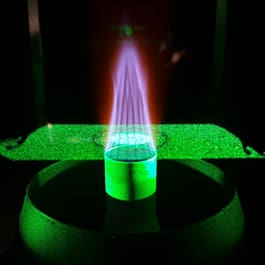



This test bench enables the simultaneous measurement of scalar and velocity fields for the quantitative determination of flow movements as well as the recording of scalar variables for the localisation of specific reaction products. By measuring both variables in parallel, the interaction of the flow behaviour and the reaction processes taking place can be analysed. In this way, a comprehensive insight into the reciprocal dynamics of hydrodynamic and chemical process influences can be gained. The structure of the simultaneous test rig is shown in the figure below.
Particle Image Velocimetry (PIV) allows the measurement of velocity fields to determine and quantify velocity gradients and vortex structures. For this purpose, very fine particles or droplets are added to the flow, on which light is scattered by two laser pulses in quick succession. By exposing the flow several times, it is possible to determine the direction of movement and speed by correlating the time-shifted images. This produces a time-averaged velocity field of the flow cross-section under consideration. The recorded velocity vectors provide detailed insights into the fluid movement of technical flow apparatus, mixing and reaction processes.
Laser-induced fluorescence (LIF) enables the localisation of individual reaction/intermediate or end products in the flow field. Depending on the wavelength used, it is possible to observe different molecules or radicals of the reaction and thus obtain a comprehensive picture of the processes taking place. Specific molecules or radicals in combustion processes can be localised and conclusions drawn about flame structures. Particularly in highly turbulent flow processes, this enables localised information about the species present and their concentration, for example in order to assign reaction sequences in the three-dimensional flow field.

